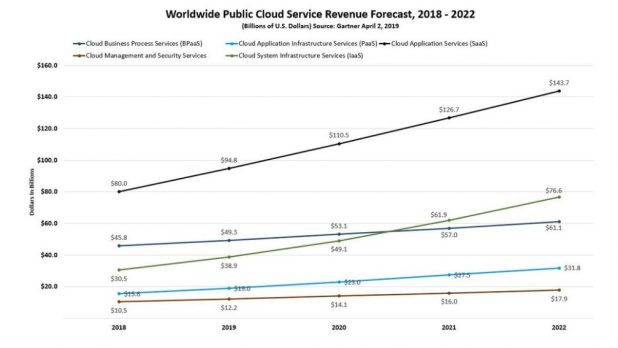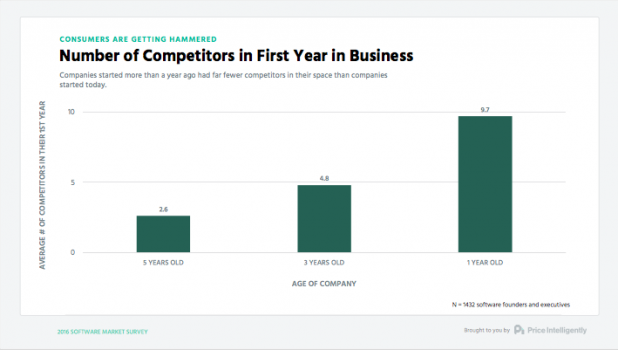The companies in the tech industry have to play by different rules. From data cabling to SaaS, the market grows but so does the competition.

Market growths are always accompanied by competition growth. Everyone wants a piece of the pie. When the pie is bigger, it’s also more tempting.

As you can see in the images above, today’s SaaS startups have a larger market but also more competitors.
And it’s not just that.
In the tech world, things change incredibly fast. Ironically enough, their customers can keep up with the changes better. Those companies that can’t deliver what empowered customers demand, perish.
With more competition, the importance of copywriting increases too.
Tech companies need to find new ways to appeal to their customers and to distill their messages so that they speak directly to the readers’ needs.
Conversions (the transition from website visitor to paying customer) is the most valuable currency in the world of digital marketing for tech companies.
The only way to boost conversion rates is extremely good copywriting.
No matter how much you invest in ads, if your copywriting isn’t on point you won’t get the conversions you want.
Case study time: Copywritech, my newly-launched digital marketing agency for tech companies, helped an iPaaS industry leader get 50% more leads and convert 25% more of those leads. All through copywriting and content writing. Check out the full case study to learn more about how we did it.
Read the case study?
Then keep reading to find out our dos and don’ts for tech copywriting and our winning framework.
Tech copywriting dos and don’ts
Tech copywriting is completely different from ‘regular’ copywriting. It has to appeal to a different audience and it has to find the perfect balance between sounding savvy and being approachable.
Here’s how to accomplish this:
DO: Speak human
The most common trap that tech companies fall into is getting uber-technical in their copy. They want to convey how special and cutting-edge their product is and they end up alienating their customers through what they perceive as technobabble.
It’s easy to understand where this is coming from: tech creators spend years (sometimes decades) building and improving their product or service. They want to showcase their work. They want their customers to know that their prices are justified by all the hard work and know-how that the product was built upon.
However, I have some sad news: customers don’t care about your hard work. They care about their own pain points.
Can you solve them?
Tell them about that.
DON’T: Talk about features instead of benefits
When you talk about customer pain points and your solution to them, you can’t get too technical.
Don’t describe how the cables you use look on the inside and on the outside. Instead, tell people why your top-tier equipment will give them future-proof networks.
Example time:
- Instead of cloud-based service say: you have access to this service from anywhere in the world and from any device
- Instead of 1TB storage space say: never fear that you will run out of storage space at the most critical moment
See where I’m going with this?
You’re not just telling people how your service or product is useful. You’re also appealing to their emotions.
DO: Make your customer the VIP
Let’s start with the examples here:
- Instead of we have developed the best project management tool say: the tool YOU need to lower your project management burden
- Instead of our customer services experts are on-call 24/7 say: call or email us anytime you run into trouble, even on weekend or in the dead of night. If you need us, we’re here.
Remember that your product is not about you. It was not created to solve your problems. Your reader is the hero of their own buyer journey. Make them feel as such.
DON’T: Make your customer feel inferior to you
Understand that there is a knowledge gap. And that that’s not your customer’s fault or a shortcoming of theirs.
Don’t use complicated technical terms to describe what should be simple processes.
When a reader doesn’t understand your copy, you’ve lost them. Why should they keep on reading? More importantly, why should they buy from you?
This is something I’ve seen even in less complex tech products. Have you ever spoken to a web developer that walks you through a myriad of options that you can’t make heads or tail of?
For instance: does a client really need to know all about breakpoints and media queries when it would be easier to understand that the developer is working on making the website responsive on mobile devices?
DO: Establish trust
Just because you have built an amazing product it doesn’t mean that your audience will buy it. They need to trust you first. They need to know you will not stop service delivery when they need you the most and that the product doesn’t crash in the middle of updates.
How can you do that?
Even if you are a brand new company, there are ways to reach new customers by appealing to your beta testers. Ask them for:
- Case studies
- Testimonials
- Reviews on your social profiles or third-party channels (like G2)
Media features (media outlets speaking about your product launch) should also be featured prominently on your website.
DON’T: Get on your high horse too early
Even the best tech products need promotion for people to learn about them. If you’re copy is written like that of Apple, you won’t get too far.
You see, Apple already has a history and a loyal fan base. If you’re just beginning, you have none of those.
Sure, you can build them.
But in the meantime, don’t expect your product to be featured on the biggest media outlets in the world. Start small – guest post wherever you can and feature any media mention prominently. This is how you build relationships.
The same goes for the tone-of-voice of your copy. I’m not saying you should be humble and make your product come across as ‘meh’. I’m saying that you need to leverage any small advantage you have and make it shine through copywriting.
The Copywritech framework for tech copy that converts
At Copywritech, we have developed our own copy and content framework that helps us deliver measurable results to our customers.
Motivation (Relevance) + Deep Pain Point Understanding – Anxiety (to Purchase) = Conversion
Allow me to explain each term.
1. Motivation/Relevance
Each visitor comes to your website for a different reason. Some of them may be intrigued by your product and want to learn more. Others might have landed there by mistake. Others might even be your competitors checking in on you, while others might be ready to purchase (ideal scenario, but lower in proportion than the others).
That’s their motivation. And there’s very little you can do about it. Sure, a catchy headline might make the customer who wasn’t ready to buy move further down the sales funnel. Or they may at least subscribe to your newsletter.
However, relevance is 100% within your control. Through copy, you can show that your product is relevant to the reader.
Briefly put, this means communicating ultra-clearly. Don’t hide behind fancy technobabble. Tell people what you do with the first text block of your website. This way, you filter the readers who may be your clients quickly. You don’t waste their time and they don’t mess up your traffic stats through useless visits.
For example, this is our website header:

It tells the whole story. It tells people what we do. Not interested? You can close our website in a few seconds instead of wasting minutes to find out what we actually do.
2. Deep pain point understanding
Now that you’ve explained what you do, show people that you are the right provider for them by making it clear that you truly understand them. You may not be the only player in your industry, but you are definitely the one that gets them best.
Here’s another excerpt from our website:

We have listed five common pain points of our customers’. This is how we show that we get tech companies and we know how to solve their problems.
As you can see, we don’t jump in to brag about how great our team is. We made our customers the heroes. Our services are about them, not us.
3. Anxiety (to Purchase)
You may have done everything right so far but the customer is still anxious to buy from you. Everyone brags on the internet, right? Why should they take your word for it?
Of course you want to sell your products and services but are they really that good?
This is where social proof comes into play.
Soothe their anxiety at the right moment: after letting them know what you do, how you do it and after showing them that you understand them, it’s time to put the final doubts to bed.
You do this by letting other people do the talking for you.
Case studies, testimonials and reviews are your best friends here. Add them to your copy, ideally right before the contact form.
84% of people trust online reviews as much as they trust recommendations from their friends. When your potential customers get to read uplifting testimonials about your services/products right before the contact form, they are automatically more inclined to fill it in.
Of course, this framework is just the skeleton of great copy for tech companies. It’s a starting point and it’s always a work in progress. Depending on the product you sell, you may need to add additional steps.
It all boils down to the buyer persona: when you know them very well, you also know whether they prefer long-form landing pages or simple and to-the-point copy. Similarly, you also know if they need an explanation for what your product does (if it’s new technology) or if they already know the concept and are just looking for the right provider.
If you’re looking for SEO content that ranks or SEO copy that converts tech buyers into paying customers, check out our case study section to learn if we’d be a good fit for you. If you want similar results to those of our existing customers, fill in the form at the bottom of the page and let’s talk!




